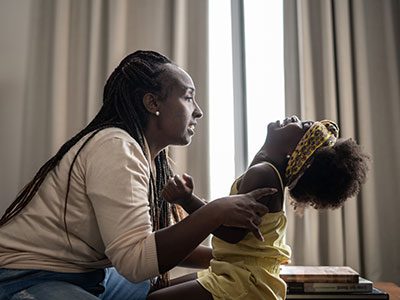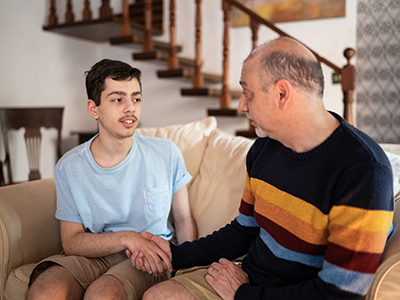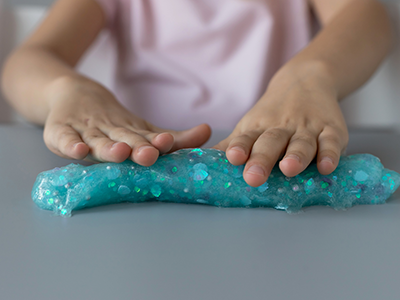Wandering, running off or what we clinically call “elopement” is a major concern for many families of children with autism and other developmental disabilities. Roughly half of autistic children will attempt to elope at least once in their lifetimes. Children most commonly elope from home, school or stores. The children who are most likely to elope have more social difficulties and lower cognitive abilities, as well as more challenges regulating emotions and coping with new situations. Children most commonly elope because they enjoy running or because they see something they are excited about. However, elopement can also be triggered by anxiety, overload and a need to escape.
Although most children who elope are safely found and recovered, elopement does increase the risk for drowning, serious injuries or being missing long-term. Unfortunately, most families say that they have gotten little or no guidance from providers about how to manage elopement and keep children safe.
What can families do if their child tends to “run off” or elope?
Families often focus on how to respond when their child elopes, but the most important and effective steps to take are to prevent a child from eloping in the first place. The National Autism Association has helpful information and free resources available for families to help with elopement.
- Increase safety at home. Adding simple visuals, like a stop sign on the door, can help. Have your child practice stopping and holding an adult’s hand every time you leave the house. Simple safety mechanisms, like out-of-reach deadbolts or chains, can help, along with adding a shop bell or alarm system to alert you when a door is opened. If you have a pool at home, be sure to place fencing around it.
- Take notes about when your child elopes. Many children have triggers or patterns to their elopement. After your child elopes and is safe again, note where you were, how your child was feeling and what was happening. Figuring out these patterns can help you learn when your child elopes and watch carefully at those times. You can also provide supports to address their needs, like noise-cancelling headphones for children who are sensitive to noise, or a preferred toy or activity for times when they must wait.
- Increase safety in the community. For children who tend to elope in public, practice specific behaviors that make eloping less likely. For example, you can practice having your child hold your hand or hold onto a shopping cart and give them praise or a small reward each time. Practice stopping and looking for cars every time you enter a parking lot or cross a street. Praise your child for doing these behaviors with you, labeling the specific behavior (e.g., “Wow, you did a great job stopping and looking for cars!”). Some families also find safety devices, such as backpacks or bracelets with a tether, to be useful.
- Engage community members. Tell neighbors, schools, babysitters and others that your child may run off, and make sure they know to contact you and emergency personnel if they see your child alone. It can be helpful to provide neighbors with a picture of your child with your contact information on it. You can also ask your local police department about registering your child, so they know how to respond in case your child is lost. Many departments also participate in Project Lifesaver, which is specifically geared to help families of those with autism and other conditions who tend to wander.
- Practice with your child what to do if they are lost. If your child can speak, practice saying their name, address and phone number. Help them identify safe people to approach if they are lost – a good rule to give is “someone in a uniform” or “a grown-up with kids.” For children who are not speaking or who struggle to use words when upset, it can be helpful to have an identification bracelet, a shoe tag or simply a card pinned to their shirt. Children who use a voice output device (or “talker”) can also have identification information programmed into their talker.
- Enroll your child in swimming/water safety lessons. The overwhelming majority of deaths related to elopement (around 90%) are by drowning. Teaching a child how to swim and the skills for being safe near water, such as never going in water without an adult, can be lifesaving. Many local pools, community organizations, and county recreational programs offer adaptive swimming lessons for children with disabilities.
- Develop a safety plan. Consider taking a daily picture of your child, which can be shared with emergency personnel if needed. Provide anyone working with or caring for your child with a safety plan that includes contact information, a photo, key medical information, warning signs, triggers and ways to help your child de-escalate to avoid elopement. Develop a plan of who can help in an emergency and key search points near locations like home and school, where your child is likely to be.
- Consider a tracking device for children who elope often. Tracking devices, like GPS, are usually a last resort. They can be expensive, are often uncomfortable to wear, and need to be charged or have batteries changed frequently. Tracking devices also tend to have a limited range, so it is important to follow all the other steps as well, and not simply rely on the tracking device. Your local police department or Project Lifesaver program may have options for free or subsidized devices.
What to do if your child elopes
It is incredibly stressful and frightening if your child elopes, and you are unable to quickly find them. Having a safety plan can help you to respond quickly and effectively. If your child does elope:
- Seek help from others as soon as possible, and be open about child’s strengths, challenges and how they may respond under stress. Do not wait; call 911 immediately. Be clear that your child has autism, and that this need to be treated as a critical case.
- Search high risk areas first. Start with the highest threat areas, including nearby water, busy streets and intersections, train tracks or busy parking lots/garages. From there, move to places that your child likes or would be interesting, exciting or comforting to them. Get others to help, if possible.
- Show a recent photo to emergency personnel and to anyone nearby who can help. If you are in a crowded place, when calling out for your child, call their name, but also add what they were wearing. For example: “Jayden! Blue shirt and black shorts!.” This can help people around you to immediately notice that you are looking for a lost child and begin helping you search.
 https://riseandshine.childrensnational.org/wp-content/uploads/2025/10/autism-image-feature.jpg
300
400
Rise and Shine
https://riseandshine.childrensnational.org/wp-content/uploads/2017/11/childrens_riseandshine_logo.jpg
Rise and Shine2025-10-28 15:41:562025-10-28 15:44:24Understanding autism beyond the headlines
https://riseandshine.childrensnational.org/wp-content/uploads/2025/10/autism-image-feature.jpg
300
400
Rise and Shine
https://riseandshine.childrensnational.org/wp-content/uploads/2017/11/childrens_riseandshine_logo.jpg
Rise and Shine2025-10-28 15:41:562025-10-28 15:44:24Understanding autism beyond the headlines





















Leave a Comment
Want to join the discussion?Feel free to contribute!